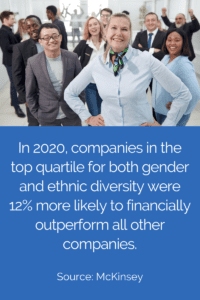Organizations should collect these key data points in order to improve their D&I strategy.
By Marta Chmielowicz
Research has shown that diversity in the workforce leads to a wealth of positive outcomes, from higher employee engagement and morale to greater productivity and innovation. McKinsey’s 2020 Diversity Wins report shows that diverse companies even have a financial advantage, with companies in the top quartile for both gender and ethnic diversity 12% more likely to financially outperform all other companies.
But creating a diverse and inclusive workforce is easier said than done. Brian Knapp, senior vice president of analytics and infrastructure at Sevenstep, says the key that many organizations are missing is data. Data can offer a real-time view into the diversity of a company’s total talent pool and reveal tension points or flaws in the process. Organizations can use this knowledge to drive a more effective strategy.
at Sevenstep, says the key that many organizations are missing is data. Data can offer a real-time view into the diversity of a company’s total talent pool and reveal tension points or flaws in the process. Organizations can use this knowledge to drive a more effective strategy.
As they embark on their D&I data journey, Knapp recommends that companies collect a range of demographic information about their job candidates at every phase of their hiring process.
He says that at a basic level, companies should measure:
- race
- age
- gender identity
More mature companies with a robust D&I program should also look at:
- disability status
- marital and family status
- ethnic identity or national origin
- religion
Finally, companies that have a fully formed program and those that work with the federal government should measure:
- veteran status
- military spouse status
- “person of color” status, or groupings of races
To collect this data, Knapp says that organizations need to make sure candidates have plenty of opportunities to report their demographic information.
“Use technology to give the candidate an opportunity to share where they fall from a diversity perspective,” he explains. “Offering this information is always optional, so you need to create opportunities for folks to willingly share their information and to do it in an easy way. The other key is to make sure you are giving the candidate a broad enough set of answers to choose from so you are not pigeonholing them artificially into a specific category, especially with gender identity. With all the options that exist out there, you have to make sure that your categories are broad enough that the candidate feels comfortable responding.”
Organizations that do this well will have a large dataset of demographic information that they can use to guide corporate strategy.














